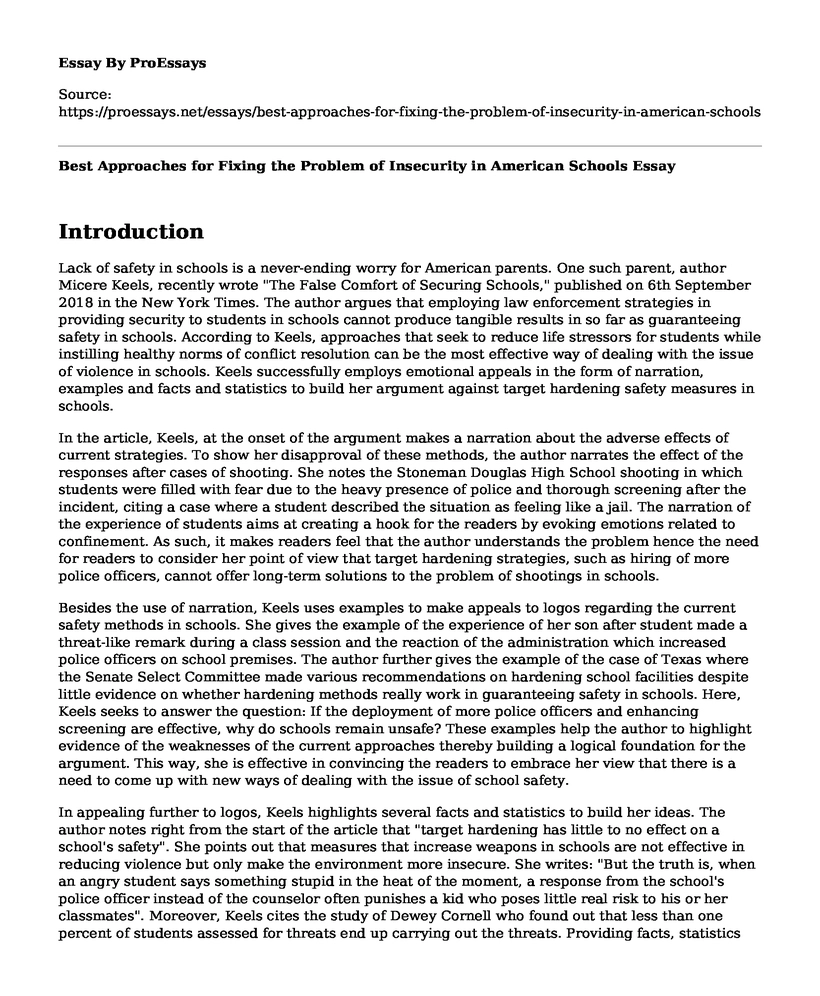Introduction
Lack of safety in schools is a never-ending worry for American parents. One such parent, author Micere Keels, recently wrote "The False Comfort of Securing Schools," published on 6th September 2018 in the New York Times. The author argues that employing law enforcement strategies in providing security to students in schools cannot produce tangible results in so far as guaranteeing safety in schools. According to Keels, approaches that seek to reduce life stressors for students while instilling healthy norms of conflict resolution can be the most effective way of dealing with the issue of violence in schools. Keels successfully employs emotional appeals in the form of narration, examples and facts and statistics to build her argument against target hardening safety measures in schools.
In the article, Keels, at the onset of the argument makes a narration about the adverse effects of current strategies. To show her disapproval of these methods, the author narrates the effect of the responses after cases of shooting. She notes the Stoneman Douglas High School shooting in which students were filled with fear due to the heavy presence of police and thorough screening after the incident, citing a case where a student described the situation as feeling like a jail. The narration of the experience of students aims at creating a hook for the readers by evoking emotions related to confinement. As such, it makes readers feel that the author understands the problem hence the need for readers to consider her point of view that target hardening strategies, such as hiring of more police officers, cannot offer long-term solutions to the problem of shootings in schools.
Besides the use of narration, Keels uses examples to make appeals to logos regarding the current safety methods in schools. She gives the example of the experience of her son after student made a threat-like remark during a class session and the reaction of the administration which increased police officers on school premises. The author further gives the example of the case of Texas where the Senate Select Committee made various recommendations on hardening school facilities despite little evidence on whether hardening methods really work in guaranteeing safety in schools. Here, Keels seeks to answer the question: If the deployment of more police officers and enhancing screening are effective, why do schools remain unsafe? These examples help the author to highlight evidence of the weaknesses of the current approaches thereby building a logical foundation for the argument. This way, she is effective in convincing the readers to embrace her view that there is a need to come up with new ways of dealing with the issue of school safety.
In appealing further to logos, Keels highlights several facts and statistics to build her ideas. The author notes right from the start of the article that "target hardening has little to no effect on a school's safety". She points out that measures that increase weapons in schools are not effective in reducing violence but only make the environment more insecure. She writes: "But the truth is, when an angry student says something stupid in the heat of the moment, a response from the school's police officer instead of the counselor often punishes a kid who poses little real risk to his or her classmates". Moreover, Keels cites the study of Dewey Cornell who found out that less than one percent of students assessed for threats end up carrying out the threats. Providing facts, statistics and examples are critical in building a logical argument about the new strategies she is proposing. Additionally, she strengthens her arguments by providing alternative approaches to fighting school violence.
Conclusion
In most occasions, I would consider Micere's text to be successful in using the highlighted devices to reinforce and sustain her argument, making her to convince the audience of her position. If Micere's primary objective was to inform Americans that current measures used in securing schools are not working, I am persuaded that she has succeeded in this respect in the article.
Works Cited
Keels, Micere. "The False Comfort of Securing Schools." The New York Times, The New York Times, 6 September 2018,
https://www.nytimes.com/2018/09/06/opinion/school-shootings-security-violence.html
Cite this page
Best Approaches for Fixing the Problem of Insecurity in American Schools. (2022, Jul 29). Retrieved from https://proessays.net/essays/best-approaches-for-fixing-the-problem-of-insecurity-in-american-schools
If you are the original author of this essay and no longer wish to have it published on the ProEssays website, please click below to request its removal:
- My Role as a Decision Leader in the Global Market Place Essay
- Case Study on Unethical Leadership: Benard Madoff
- Research Paper on Information Security Plan
- Chinese Culture and Impact on Organizational Behavior Paper Example
- Growth & Development of Children: Teacher's Role & Child's Needs - Essay sample
- Virtual Teams: Unlocking Global Talent, Skills & Potential - Essay Sample
- Essay Sample on Essentialism: Teaching Students Core Knowledge and Patriotism







